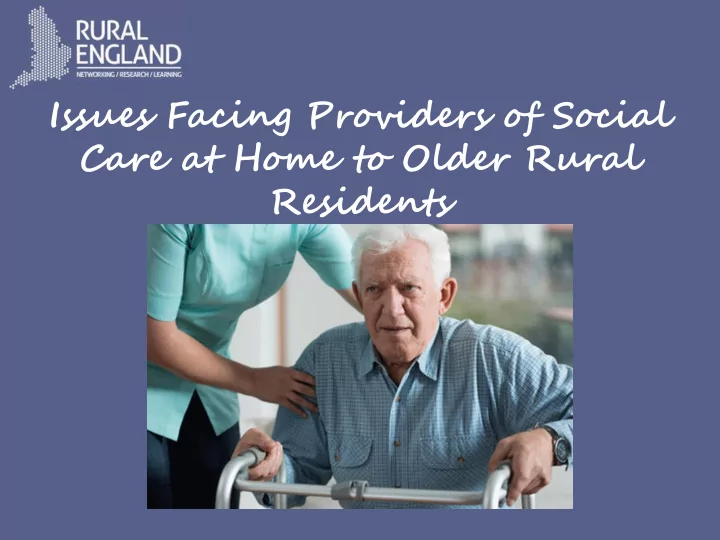

Issues Facing Providers of Social Care at Home to Older Rural Residents
The Rural Challenges to delivering home-based Social Care Demographics of an ageing population Sparsity – Penalty of distance - Higher travel costs, opportunity costs and unproductive time for staff – Lower population density - Impeding economies of scale. Higher per unit costs • …..and other factors of rurality
Older and rapidly ageing population 17.7% of the population of England aged over 65 22.8% in rural areas 15.6% in urban areas 2.4% of the population of England aged over 85 3.0% in rural area 2.1% in urban areas The gap between urban and rural is widening Calculated from ONS 2015 estimates
Percentage of usual resident population who are 85 years old and over, Census 2011
Actual and projected number of people aged 65 and over in England by age Trend that will group, 2015/16 to 2035/36 continue Age UK - Briefing: Health and Care of Older People in England 2017 (February 2017)
Calculated from 2014-based sub national population projections - ONS
“Increases in life expectancy have outpaced improvements in disability free life expectancy as a result more of us are spending more time in later life with multiple long-term conditions, frailty, dementia and social care needs.” (Age UK 2017)
National Statistics and existing research Little research or statistical information specifically considers rural areas. Widely identified National trends include: • The number of people getting state funded help has fallen . (Kings Fund 2016) • The gap between need and funding has grown wider since 2010 • Most care to older people is provided by family members. Demand for care is projected to increase but there is no increase in the numbers of potential next generation carers.
Rural Issues Available statistics do however demonstrate that rural areas have • Higher rates of unpaid care • Higher hourly costs of home care • Higher rates of Delayed Transfers of Care from Hospital (DToC)
Informal Care • Nationally most care for older people is provided by family members (McNeil and Hunter 2014). • The number of older people in need of care is predicted to outstrip the number of family members available to provide it • Older rural residents are much more likely to provide some form of care to one another
Hourly costs of home care Average Hourly Rates for Externally Provided Home Care 2015/16 Local Authority Classification Average Hourly Rate Predominantly Rural £15.61 Urban with Significant Rural £14.87 Predominantly Urban £13.78 England £14.28 Calculated from NHS statistics
Delayed Transfers of Care from Hospital Delayed Transfer of Care. Monthly average days per 100,000 population aged over 18 years, 2016/17 Local Authority Classification All reasons Predominantly Rural 19.2 Urban with Significant Rural 16.7 Predominantly Urban 13.0 England (average) 15.0 Calculated from NHS statistics
Other rural factors • Older housing stock which may be of unsuitable design and hard to heat • Shortage of suitable housing types in general stock • Loss of carers because of lack of affordable housing • Lack of supported/ extra-care accommodation • Problems accessing services including Health Care • Social and physical Isolation
The Three Case Studies North Yorkshire Shropshire Cornwall
Challenges because of Sparsity Distance = cost – time and money Dispersed = cost of time Weak market for providers
Consequences High costs Care Contracts handed back Delays with Care Assessments Difficulty providing ANY care package Delayed hospital discharge Crisis re-admission
Other factors Small pool of potential carers Low pay and low status no career or up-skilling opportunities Increasingly complex needs of clients Difficulties of retention
Reaching health care Social Isolation Fuel Poverty Lack of appropriate accommodation
Are these challenges being tackled in case study areas? NOT through Sustainability and Transformation Plans (STPs) Better Care Fund is supporting new initiatives North Yorkshire • Stronger Communities Programme • Living Well Programme
Research Reflections How might rural challenges be addressed Better Government funding responsive to rural challenges Need for Rural Proofing of : Sustainability and Transformation Plans Commissioning of Social Care Ad hoc Examples of great community action, but • not all communities have the skills or time to deliver With proper funding social care can reach rural residents : Clustering of social care services Hubs – providing range of support/accommodation But MUST be TRULY accessible ‘hubs’ – transport/outreach Give older rural residents a voice – Go to them
Vulnerable Older People have a legal entitlement to have their needs met Are those in rural areas are missing out?
Recommend
More recommend